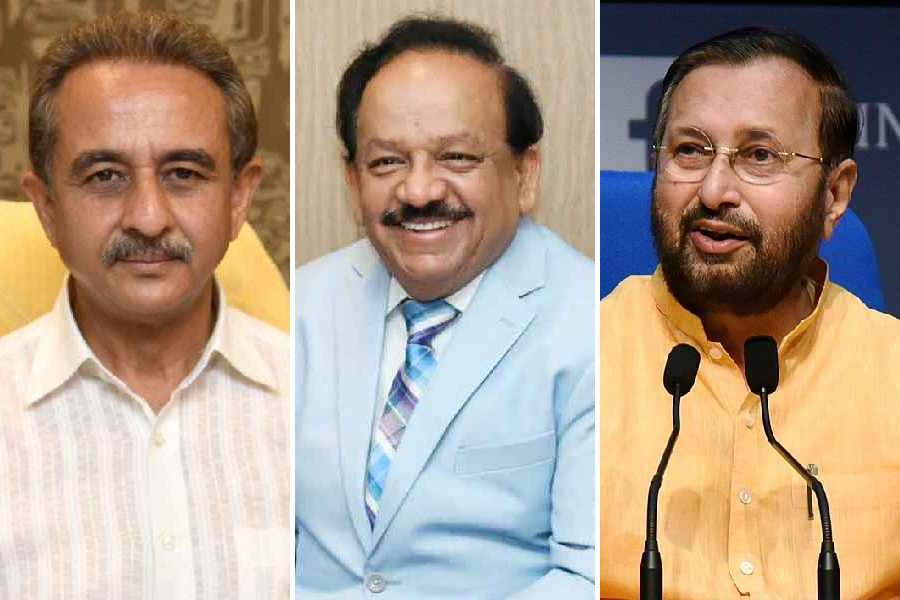 |
| Bekti fillets rolled in poppy seeds and drumstick leaves with sambar sauce |
My parents-in-law had a stream of visitors dropping in at all odd hours in their central Delhi house. And one of the reasons for the constant flow of guests was the drumstick tree in their backyard. Everybody — from their Tamilian neighbour to the Bengali relative and the Bihari auto-rickshaw driver —wanted to take home a bundle of drumsticks. And the Moringa tree was most obliging. Its branches drooped with luscious fruit that never failed to catch the passerby’s eye.
I have to admit that I was never much of a drumstick fan — not unless it was being wielded by Ginger Baker. But my Bengali relatives and south Indian friends become a bit moony-eyed when they talk of drumsticks. The Bengalis love it in their chorchori, shukto and maachher jhol, and no good sambar is ever really ready without the mandatory drumsticks in it. On the other hand, in western Uttar Pradesh, where I grew up, a drumstick is as rare as an indigenous Nobel laureate.
That’s why I wasn’t greatly enthused to begin with when chef Pradip Rozario, who runs the restaurant K.K.’s Fusion in Calcutta, mentioned drumsticks as an ingredient in new wave dishes. I demurred, but the chef pointed out that he wasn’t talking about using drumsticks in the usual way — in mixed veggie dishes or in dal. Let’s cook them in innovative ways, he suggested.
 |
| Jumbo prawns in drumstick and tomato sauce |
Indeed, I cannot quarrel with his recipe of a mélange of fish in a sauce flavoured with drumsticks — called shojney daanta in Bengali and sajna in Hindi. And when he uses drumsticks in an aromatic tomato sauce lathered over jumbo prawns, the vegetable gets an image makeover that cannot but impress. “You can do all kinds of things with drumsticks,” chef Rozario declares.
The chef has old memories of being fed drumsticks as a child. His grandfather used to tell him: “Eat drumsticks every day and do free-hand exercises, and you won’t have to go to the gym ever.” Well, it does have a whole lot of properties. The leaves and pods are full of iron and vitamins and are said to enhance immunity.
I remember being served a dish of drumstick leaves at a Maharashtrian friend’s house many moons ago. And though many of my friends love the sajna leaves, I must say I didn’t quite take to the mildly bitter taste of the leaves. I recall promising myself that I wouldn’t eat them willingly again.
However, I may have to eat my words — along with the leaves. Chef Rozario’s creation — bekti fillet rolled in poppy seeds and drumstick leaves and served in a sambar sauce — promises to wipe out my fear of Moringa leaves. To top it, an organisation called Trees for Life International tells us that Moringa leaves contain seven times more Vitamin C than oranges, four times more Vitamin A than carrots, four times more calcium than milk, three times the potassium that you get in bananas and double the protein you get from yoghurt. And in some quarters they even believe that drumsticks work like an aphrodisiac.
Clearly, drumsticks, its flowers (also cooked in traditional dishes) and leaves are not to be trifled with. So if you, as the chef suggests, have a dish of prawns and drumstick chorchori, you’ll boost your system with all kinds of nutrition. And the dish is not just tasty but easy to prepare as well.
To begin with, mix prawns with salt and lime juice and set aside. Now roast dry red chillies and mustard seeds and grind them into a paste with a little bit of water. Then heat oil and fry the prawns until they are a little pink in colour. Take them out with a slotted spoon, and in the same pan fry some onions, garlic and ginger paste and the roasted red chilli paste. Add the prawns, drumsticks cut into fingers and pumpkin cubes. Sauté some more, and then add a bit of vinegar. Let it simmer. Now add some water, sugar and salt — and cook till it’s done.
I feel a little bad about being mean to the poor drumstick all these years. The humble pod, in fact, is not just a much loved ingredient in many parts of the country (and elsewhere in south Asia and Southeast Asia too) but does India proud. I read somewhere that India is the largest producer of Moringa. Every year, it produces 1.1 to 1.3 million tonnes of the fruit. And all this, of course, not counting the fruit from my in-laws’ backyard that made so many people happy!
Mustard flavoured hilsa with drumsticks (serves 4-6)
Ingredients:
• 1kg hilsa • 2 large prawns (with shell) • 2 tbs mustard paste • 4 chopped green chillies • 2 chopped onions • 2 drumsticks cut into fingers • 4 tbs vegetable oil • 2 tsp sugar • 1 tbs ginger and garlic paste • salt to taste
 |
Method:
Clean and wash prawns. De-vein the prawns. Marinate the fish and prawns in ginger garlic paste and salt and keep aside. Heat oil and fry the onions until brown. Add the fish and drumsticks and stir. Add seasoning, mustard paste, chillies and water. Simmer for 15 minutes and then remove from the heat. Put the shelled prawns and cover with a lid for 10 minutes. Open the lid and place the hilsa and drumstick pieces on a dish. Garnish with the prawns.










